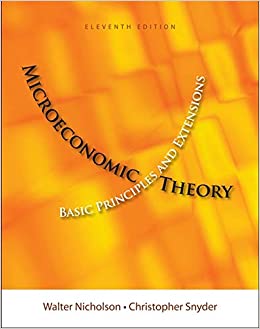
Microeconomic Theory 11th Edition by Walter Nicholson,Christopher Snyder
Edition 11ISBN: 978-1111525538
Microeconomic Theory 11th Edition by Walter Nicholson,Christopher Snyder
Edition 11ISBN: 978-1111525538 Exercise 2
Suppose that firms' marginal and average costs are constant and equal to c and that inverse market demand is given by P = a - bQ, where a, b 0.
a. Calculate the profit-maximizing price-quantity combination for a monopolist. Also calculate the monopolist's profit.
b. Calculate the Nash equilibrium quantities for Cournot duopolists, which choose quantities for their identical products simultaneously. Also compute market output, market price, and firm and industry profits.
c. Calculate the Nash equilibrium prices for Bertrand duopolists, which choose prices for their identical products simultaneously. Also compute firm and market output as well as firm and industry profits.
d. Suppose now that there are n identical firms in a Cournot model. Compute the Nash equilibrium quantities as functions of n. Also compute market output, market price, and firm and industry profits.
e. Show that the monopoly outcome from part (a) can be reproduced in part (d) by setting n = 1, that the Cournot duopoly outcome from part (b) can be reproduced in part (d) by setting n = 2 in part (d), and that letting n approach infinity yields the same market price, output, and industry profit as in part (c).
a. Calculate the profit-maximizing price-quantity combination for a monopolist. Also calculate the monopolist's profit.
b. Calculate the Nash equilibrium quantities for Cournot duopolists, which choose quantities for their identical products simultaneously. Also compute market output, market price, and firm and industry profits.
c. Calculate the Nash equilibrium prices for Bertrand duopolists, which choose prices for their identical products simultaneously. Also compute firm and market output as well as firm and industry profits.
d. Suppose now that there are n identical firms in a Cournot model. Compute the Nash equilibrium quantities as functions of n. Also compute market output, market price, and firm and industry profits.
e. Show that the monopoly outcome from part (a) can be reproduced in part (d) by setting n = 1, that the Cournot duopoly outcome from part (b) can be reproduced in part (d) by setting n = 2 in part (d), and that letting n approach infinity yields the same market price, output, and industry profit as in part (c).
Explanation
a) The inverse market demand curve is gi...
Microeconomic Theory 11th Edition by Walter Nicholson,Christopher Snyder
Why don’t you like this exercise?
Other Minimum 8 character and maximum 255 character
Character 255


